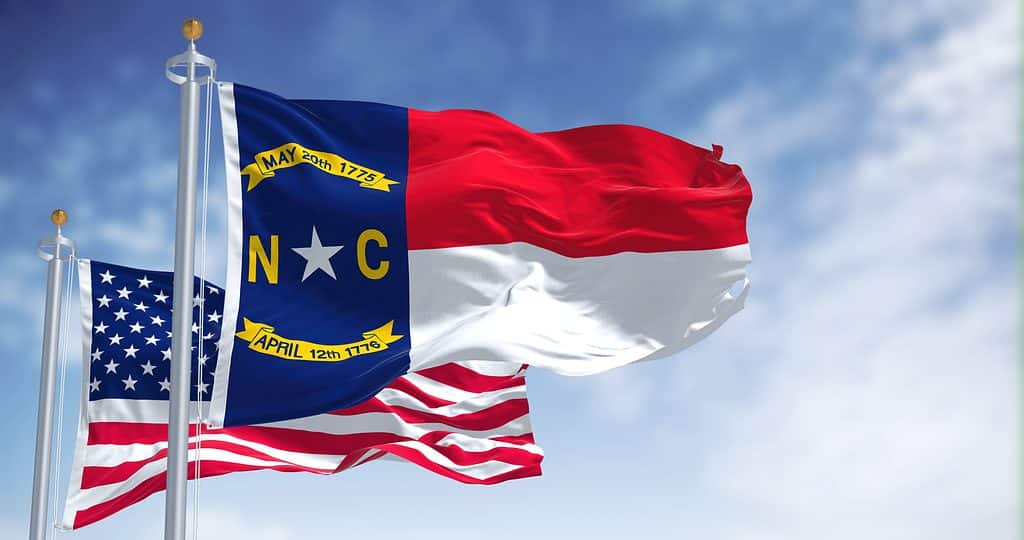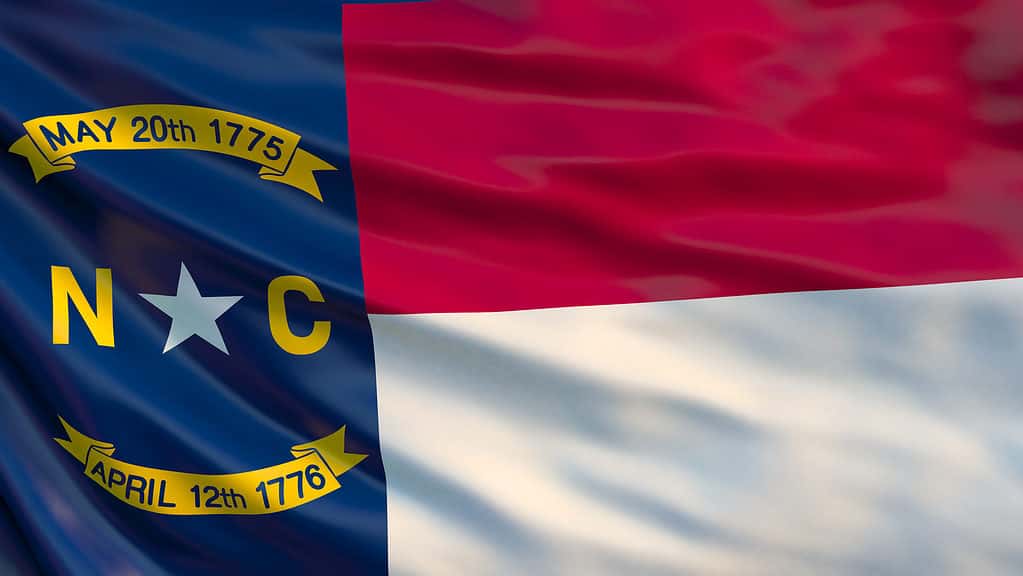Exactly one month after North Carolina’s secession from the Union in 1861, the state adopted its first official flag. Flag designer William G. Browne, an artist residing in Raleigh, created the design. Johnston Jones, who served as state adjutant general in 1885, introduced the first of two subsequent flag designs. The flag has not changed much since. In this article, we will explore the flag of North Carolina further, including its history, meaning, and symbolism.
The Flag of North Carolina History

The North Carolina state flag waving along with the national flag of the United States of America. North Carolina is a state in the Southeastern region of the United States with a history of its flag dating back to the 1700s.
©rarrarorro/Shutterstock.com
1700s
North Carolina’s colonial era was dominated by the English flag. The St. George’s Cross was flown as the national flag prior to the Union in 1707. After 1707, the Union flag featured a blue background with a white St. Andrew’s Cross and a red St. George’s Cross, representing Scotland and England, respectively. In 1771, when fighting broke out at Alamance during the War of Regulation, Lord William Tryon took two identical flags to the field.
1861
A large number of state-made flags may have flown throughout the Revolution, but we know very little about them. There was never a North Carolina flag prior to the 1861 constitutional convention. North Carolina’s flag was conceptualized by John D. Whitford of Craven County. It features a blue field, a white V in the center, and a star bearing the Latin word “Surgit astrum, May 20, 1775.” The convention’s delegates organized a flag committee but settled on a design that was distinct from Whitford’s.
The committee in charge of selecting the flag for the convention went with a different design that Whitford proposed. The flag features a crimson background with a white star in the middle with the dates “May 20, 1775” and “May 20, 1861” written in a semicircle above and below the star, respectively. The new design may have been influenced by William G. Browne, an artist from Raleigh. The date comes from the debunked Mecklenburg Declaration of Independence, which claims to have been issued in 1775. On June 18, 1861, the North Carolina legislature passed a resolution declaring independence. On June 22, 1861, an ordinance pertaining to the use of the national flag was ratified.
1885
The current flag wasn’t officially adopted until 1885. Both the Mecklenburg Declaration of Independence (May 20, 1775), and the secession from the Union on May 20, 1861, are remembered on the 1861 flag.
Until 1885, when a new flag design was presented by the state assembly, North Carolina used the one adopted in 1861. It had a blue union with a white star in the center, a gilt N to the left, and a gilt C to the right, with scrolls above and below reaffirming the date of the Mecklenburg Declaration of Independence and revising the second date to April 12, 1776, to acknowledge the Halifax Resolves. Despite the contentious history of the Mecklenburg Declaration of Independence, the flag has remained largely unchanged since 1885. Current flag was introduced in 1991.
The Flag of North Carolina Design

The North Carolina state flag has a bicolor of red and white. It has a 5 white pointed star, with the letters N and C flanking it. The date May 20th, 1775 is above and April 12th, 1776 is below.
©Maksym Kapliuk/Shutterstock.com
On the North Carolina flag, the blue union occupies one-third of the length and the entire width. The remaining area is a horizontal bicolor of red and white. The blue union is centered by the white five-pointed star, and the gold initials “N” and “C” flank it. May 20th, 1775, appears on the scroll above them, and April 12th, 1776 appears on the scroll below them.
Flag of North Carolina Symbolism
The official colors of the State of North Carolina are red and blue. The color blue stands for alertness, resolve, and justice; the color red for toughness and bravery; and the color white for innocence and purity. A white star sits between the initials “N” and “C” to represent North Carolina’s status as one of the original thirteen colonies. The letters “N” and “C” were added to symbolize North Carolina. The star is also a symbol of the state.
The two dates on the flag of North Carolina have significant meaning as well. May 31, 1775, remembers the Mecklenburg Resolves, a declaration published by a committee in Charlotte a few weeks after the first battles of the American Revolution in Concord and Lexington. There was a call to abolish the King’s rule in the document.
The second date is April 12, 1776, when the Halifax Resolves were adopted. The Halifax Resolves, passed by the North Carolina colony months before the Declaration of Independence, made that state the first to formally ask for independence from Great Britain. The state of North Carolina was first.
Click here to learn about every single flag in the world!
Up Next:
- The Flag of Greenland: History, Meaning, and Symbolism
- The Flag of Iraq: History, Meaning, and Symbolism
- The Flag of Benin: History, Meaning, and Symbolism
The photo featured at the top of this post is © GJones Creative/Shutterstock.com
Sources
- NC Pedia, Available here: https://www.ncpedia.org/symbols/flag
- US Flags, Available here: https://usflags.design/north-carolina/
- The North Carolina 100, Available here: https://thenorthcarolina100.com/history/2016/04/05/understanding-date-on-nc-flag/10877#:~:text=What%20do%20the%20two%20dates%20on%20the%20North,document%20called%20for%20nullification%20of%20the%20King%E2%80%99s%20authority.
Thank you for reading! Have some feedback for us? Contact the AZ Animals editorial team.






